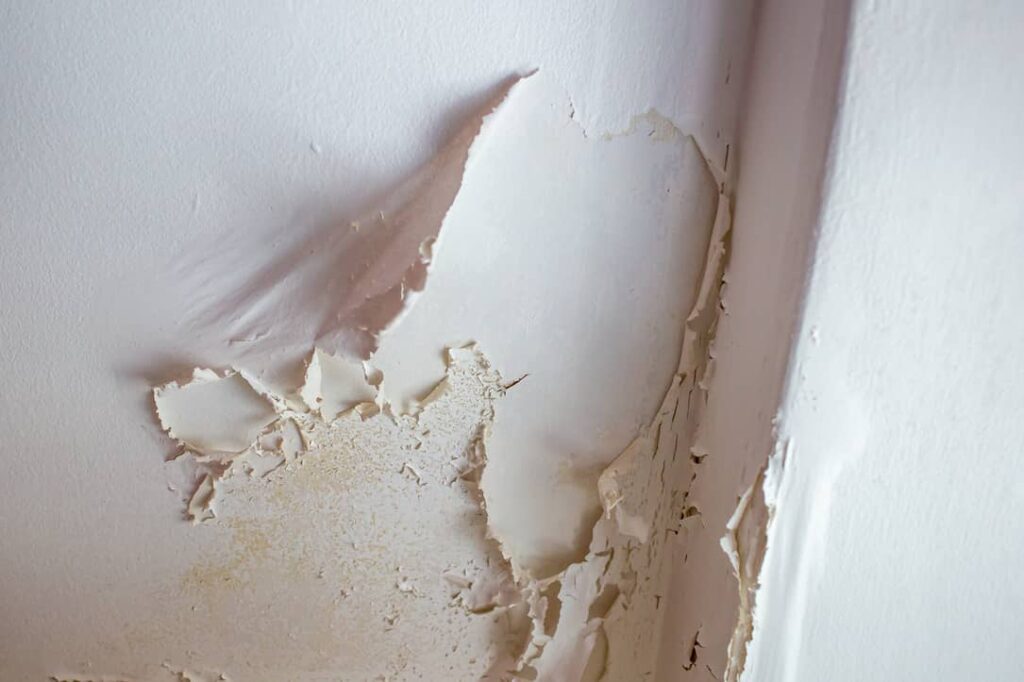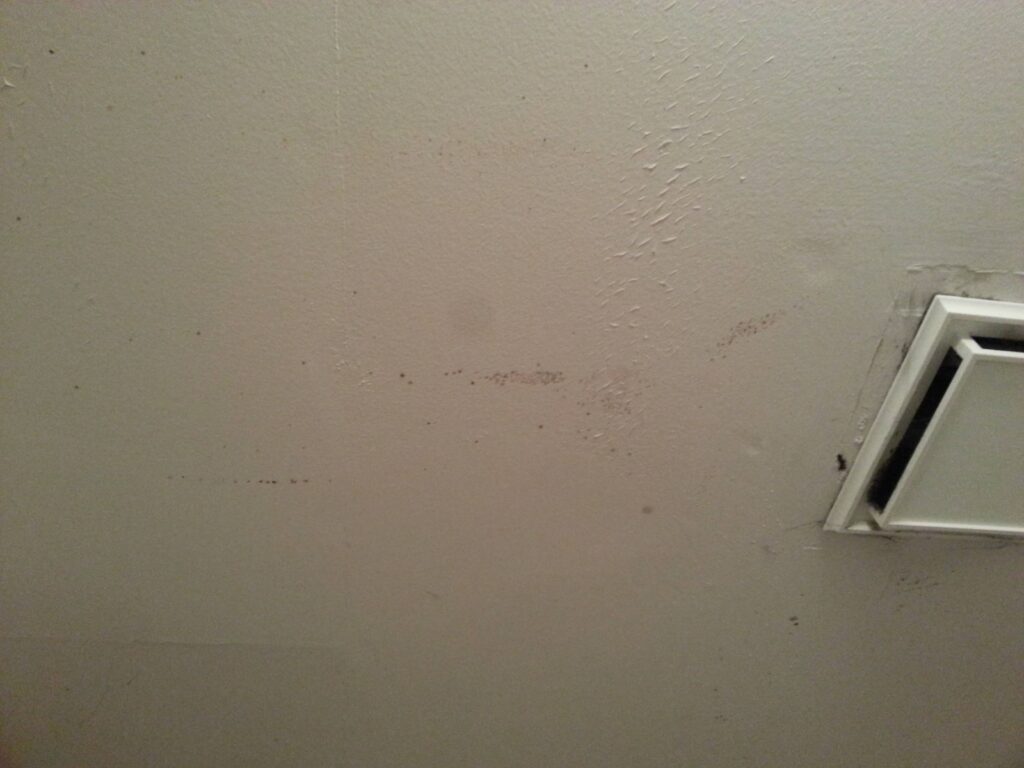In this article, you will learn about the potential damage that mold can cause to a painted ceiling. Mold can be unsightly and can also pose health risks, so it is important to address any signs of mold growth in your home. Many people wonder whether mold on a painted ceiling can actually damage the paint, and we will delve into this topic to provide you with the information you need.
The short answer is yes, mold can indeed cause damage to the paint on a ceiling. Mold is a type of fungus that feeds on organic matter, and paint is an organic material. When mold grows on a painted surface, it can release enzymes that break down the paint and cause it to deteriorate. Over time, this can lead to discoloration, peeling, and flaking of the paint. It is important to address mold growth promptly to prevent further damage to your painted ceiling.
What is Mold?
Mold is a type of fungus that can grow on various surfaces, including painted ceilings. It thrives in damp and humid environments and can spread rapidly if not addressed. Mold can be black, green, or other colors, and it often appears as patches or spots on surfaces.
Definition of Mold
Mold is a term used to describe various types of fungi that grow in multicellular filaments called hyphae. These fungi reproduce by producing spores, which can be released into the air and subsequently inhaled. Mold can grow on any organic material, including wood, paper, fabric, and even painted surfaces.
Types of Mold
There are numerous types of mold that can grow on painted ceilings, but some common ones include Aspergillus, Cladosporium, and Stachybotrys (also known as black mold). Each type of mold has its own characteristics and may pose different health risks if left untreated.
Causes of Mold Growth on Painted Ceilings
Moisture and Humidity
The primary cause of mold growth on painted ceilings is excess moisture and humidity. When a ceiling is exposed to high levels of moisture, such as from leaks or condensation, the conditions become ideal for mold to thrive. The moisture provides a necessary environment for mold spores to germinate and grow.
Poor Ventilation
Inadequate ventilation can also contribute to mold growth on painted ceilings. Without proper airflow, moisture can become trapped in the space between the ceiling and the roof or the ceiling and the floor above. This stagnant moisture creates a perfect breeding ground for mold.
Water Leaks
Water leaks are another common cause of mold growth on painted ceilings. Whether due to a plumbing issue or a leaky roof, any form of water intrusion can lead to mold infestation. The water seeps into the ceiling and provides the necessary moisture for mold to thrive.

Effects of Mold on Painted Ceilings
Discoloration and Stains
One of the visible effects of mold on painted ceilings is discoloration and stains. Mold can leave dark patches or streaks on the ceiling, which can be unsightly and difficult to remove. The longer the mold is left untreated, the more prominent the discoloration becomes.
Peeling and Blistering
Another consequence of mold growth on painted ceilings is the peeling and blistering of the paint. As mold spreads beneath the painted surface, it can cause the paint to lose adhesion and bubble up. This can lead to the paint peeling and flaking off the ceiling, creating an uneven and damaged appearance.
Bubbling and Warping
In severe cases, mold growth can cause the ceiling surface itself to bubble and warp. As the mold continues to multiply and spread, it can generate enough pressure to distort the surface of the ceiling. This not only damages the paint but can also compromise the structural integrity of the ceiling.
Health Risks of Mold Infestation
Respiratory Issues
Exposure to mold spores can trigger respiratory problems, especially in individuals with pre-existing conditions such as asthma or allergies. Inhaling mold spores can irritate the airways and lead to symptoms such as coughing, wheezing, shortness of breath, and sinus congestion.
Allergic Reactions
Many people are sensitive to mold allergens, which can cause allergic reactions. These reactions may include sneezing, itching, red or watery eyes, and skin rashes. Some individuals may also develop more severe allergic reactions, such as hives or difficulty breathing, when exposed to mold.
Weakened Immune System
Certain types of mold, such as black mold, produce toxins called mycotoxins. Prolonged exposure to these toxins can weaken the immune system, making individuals more susceptible to infections and other health problems. People with compromised immune systems, such as the elderly or those with underlying medical conditions, are particularly at risk.

Methods to Prevent Mold on Painted Ceilings
Keep the Ceiling Dry
The most effective way to prevent mold growth on painted ceilings is to keep the area dry. Regularly inspect the ceiling for any signs of moisture or leaks, and promptly address any issues that arise. Maintain proper ventilation in the room to ensure airflow and minimize humidity levels.
Improve Ventilation
Improving ventilation can help prevent mold growth on painted ceilings. Ensure that the room has adequate ventilation, such as through windows, exhaust fans, or air conditioning units. Proper airflow can help keep the ceiling dry and reduce the likelihood of mold infestation.
Address Water Leaks Promptly
If you notice any water leaks in your home, it is crucial to address them promptly. Whether it is a leaky pipe or a roof leak, the longer the water is allowed to penetrate the ceiling, the higher the chance of mold growth. Fix any leaks as soon as possible to prevent mold from developing.
Detecting Mold Growth on Painted Ceilings
Visual Inspection
Performing a visual inspection is one way to detect mold on painted ceilings. Look for any signs of discoloration, stains, or patches that could indicate the presence of mold. Pay attention to areas with noticeable moisture or a musty odor.
Musty Odor
Mold often emits a distinct musty odor. If you notice an unpleasant smell coming from your painted ceiling, it could be an indication of mold growth. Trust your nose and investigate further to confirm whether there is a mold infestation.
Professional Mold Testing
If you suspect mold but are unsure of its presence or extent, it may be necessary to seek professional mold testing. Certified mold inspectors can conduct air or surface sampling to determine the presence of mold spores and identify the type of mold present. This can help provide a more accurate assessment of the mold situation and guide appropriate remediation actions.

Steps to Remove Mold from Painted Ceilings
Ensure Safety Measures
Before attempting to remove mold from a painted ceiling, it is imperative to take proper safety measures. Wear protective equipment, such as gloves, goggles, and a mask, to minimize exposure to mold spores. This is particularly important for individuals with respiratory conditions or compromised immune systems.
Scrubbing and Cleaning
To remove mold from a painted ceiling, begin by scrubbing the affected area with a mixture of warm water and mild detergent. Use a soft brush or sponge to gently scrub away the mold. Avoid using harsh chemicals or bleach, as these can damage the paint.
Proper Disposal
Dispose of any materials used during the mold removal process in a sealed plastic bag. This prevents the spread of mold spores to other areas of the home. It is also essential to thoroughly clean and disinfect all tools and surfaces used during the remediation process to prevent cross-contamination.
Tips for Treating Mold-Infested Painted Ceilings
Use Mold-Inhibiting Paint
One way to prevent mold regrowth on a painted ceiling is to use mold-inhibiting paint. These types of paint contain antimicrobial agents that help prevent the growth of mold and mildew. Applying a layer of mold-inhibiting paint after cleaning and treating the ceiling can provide an additional barrier against future infestations.
Address Underlying Issues
Treating mold on a painted ceiling is only part of the solution. It is crucial to identify and address the underlying issues that contributed to the mold growth. Whether it is a leaky roof, poor ventilation, or high humidity, addressing these issues will help prevent mold from returning in the future.
Regular Maintenance
Maintaining the cleanliness and dryness of the painted ceiling is essential for preventing mold. Regularly inspect the ceiling for any signs of moisture or mold growth and take prompt action if any issues are identified. Additionally, ensure that the room has adequate ventilation to prevent excess humidity.

Professional Help for Mold Remediation
Choosing a Reliable Mold Remediation Company
In some cases, it may be necessary to seek professional help for mold remediation on a painted ceiling. When choosing a mold remediation company, look for one that is certified and experienced in handling mold-related issues. Read reviews and ask for referrals to ensure you select a reliable and trustworthy service provider.
Understanding the Remediation Process
Professional mold remediation typically involves a series of steps to effectively remove mold and prevent its regrowth. This may include containment of the affected area, removal and disposal of contaminated materials, thorough cleaning and sanitization, and the use of specialized equipment to address any underlying moisture issues.
Post-Remediation Assessment
Following mold remediation, it is important to conduct a post-remediation assessment to ensure the effectiveness of the remediation efforts. A certified mold inspector can perform air or surface sampling to verify that the mold has been successfully removed and that the area is safe for occupancy.
Conclusion
While mold on a painted ceiling can cause damage to the paint, its impact extends far beyond aesthetics. Mold growth can lead to health risks, such as respiratory issues and weakened immune systems. Prevention is key to avoiding mold infestations, and addressing underlying issues, improving ventilation, and keeping the ceiling dry can help minimize the risk. If mold is present, proper removal techniques and maintenance practices are necessary to ensure a safe, mold-free environment. Seeking professional help may be necessary for more extensive mold infestations. By taking proactive measures, you can protect your painted ceiling and maintain a healthy indoor environment.
